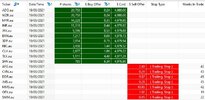MovingAverage
Just a retail hack
- Joined
- 23 January 2010
- Posts
- 1,315
- Reactions
- 2,565
Because of the specific exit I use in that system I know that historically rapid rises like this tend to give back (not all). This particular trade is an outlier and I know how my system responds to similar scenarios—hence my concern.???
You have a system, do have gains you are afraid to loose and want to override your system.
At the very least,give a chance to your system to be proven right and instead of putting a sell order, put a sl order.
Conditional sell...
Anyway,just my view, each to his her own





